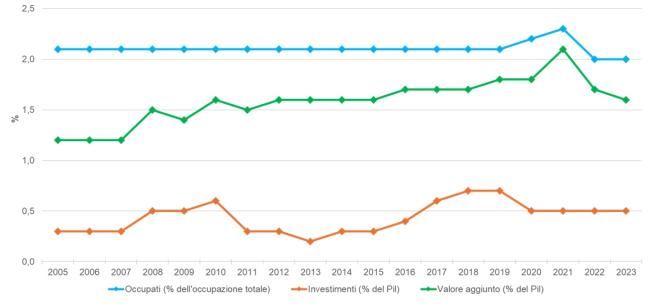Panel 1
Cristina Frizza
From 2005 to 2023, in Italy, the circular economy sector showed signs of economic strengthening, with an increase in value added (+0.4 percentage points on GDP) and investments (+0.2 points), but a decrease in relative employment (-0.2 points), highlighting the need for policies that accompany the transition with greater attention to inclusion and the social dimension of circular work.
The indicator includes data on employment, value added and investments in the circular economy sector. The methodology developed by Eurostat to derive such statistical information on economic activities dealing with the circular economy is based on:
- a conceptual framework that includes the definition of the circular economy and the criteria for defining the related economic activities. The latter point makes use of the classification “10R framework for circular economy (refuse; rethink; reduce; re-use; repair; refurbish; remanufacture; repurpose; recycle; recover)”;
- the identification of relevant economic activities within the integrated system of classifications of economic activities, goods and services (NACE, CPA and PRODCOM) and the related estimation procedure of the variables employment, value added and investments.
The purpose is to measure the contribution of economic activities to the circular economy, in employment and monetary terms (value added and investments).
Communication COM(2020) 98 final of 11 March 2020 “A new Circular Economy Action Plan – For a cleaner and more competitive Europe”
Ministerial Decree no. 259, of 24 June 2022, which approves the National Strategy for the Circular Economy, as a programmatic document aimed at identifying the actions, objectives and measures to be pursued in defining institutional policies to ensure an effective transition towards a circular type economy.
Panel 2
Eurostat Metadata "Private Investment, Jobs and Gross Value Aided Related to circular economy sectors": https://ec. europa. eu/eurostat/cache/metadata/en/cei_cie011_esmsip2. htm
-
Data quality assessment
Eurostat (Statistical Office of the European Communities)
Dataset Eurostat:
https://ec. europa. eu/eurostat/databrowser/view/cei_cie011/default/table? lang=en&cattery=cei. cei_cie
https://ec. europa. eu/eurostat/databrowser/view/cei_cie012/default/table? lang=en&cattegory=cei. cei_cie
National
2005-2023
Indicator assessment
The indicator is calculated with a methodological framework according to the following three steps.
- Conceptual framework. The delimitation of economic activities related to the circular economy was determined through a classification of the circular economy based on the purpose of the activity (sector classification by purpose).
- The activities relevant to the circular economy were identified and compared with the integrated system of economic classifications (NACE, CPA, PRODCOM). Different estimation methodologies are used to identify the share of “circularity” in each economic activity.
- Delineation and compilation of data.
More information is available in the “Annexes” section of the Eurostat metadata: https://ec.europa.eu/eurostat/cache/metadata/en/cei_cie011_esmsip2.htm
IIn 2023, the status can be defined as medium compared to the European context. The main indicators show values close to the EU average: the share of employees in the circular economy sector is equal to 2% (in line with the European average); the sector’s value added on GDP is equal to 1.6% (compared to 1.8% in the EU); investments represent 0.5% of GDP (against 0.8% at European level) (Tables 1 and 2).
From the analysis of the trend from 2005 to 2023, the trend is almost stable, highlighting a slightly stronger growth for the incidence of value added of the circular economy sector, which increases by 10.4 percentage points (Table 1 and Figure 1).
Data
Table 1: Employment, value added, and investments in the circular economy sector in Italy
Eurostat
Table 2: Circular economy sector employment, value added, and investment shares relative to total figures in Europe
Eurostat

Innovation and investments in eco-design, secondary raw materials, recycling processes and industrial symbiosis represent the pillars of the transition towards a circular economy in Italy. The crucial role of these activities is not limited to the improvement of resource efficiency and the reduction of environmental impacts, but also extends to the promotion of sustainable and inclusive economic growth, fostering the creation of new jobs and the reduction of inequalities.
The data relating to the period 2005-2023 indicate a positive dynamic regarding value added and investments in the circular economy sector, which increased by 0.4 and 0.2 percentage points respectively in relation to GDP. This increase suggests a strengthening of the sector’s productive and financial capacities, reflecting the effectiveness of policies aimed at stimulating the circular transition.
However, the contraction of the share of employees in the sector (-0.2 percentage points on the total employed) raises some critical issues (Table 1 and Figure 1). Considering that circular activities – such as recycling, repair and reuse – are traditionally labor intensive, this trend could indicate greater automation, a reallocation of labor resources to other sectors or potential gaps in training policies and inclusion of human capital.